Note: This publication is currently undergoing major revisions. The current publication will be replaced with a new publication based on stakeholder requirements and scientific advances. We expect to begin sharing details on this soon. If you have input on content, format, or publication frequency at any time, please contact us at cbrfc.webmasters@noaa.gov.Lower Colorado Water Supply Outlook, March 1, 2010Lower Colorado Water Supply Outlook, March 1, 2010
Contents
Lower Colorado Summary
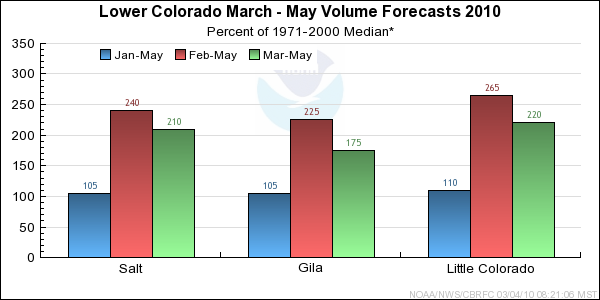
*Median of forecasts within each basin.
Salt Basin Conditions
The following conditions influenced this month's forecasts:
Precipitation:
Seasonal October-February
precipitation ranged from near 110 to
125 percent of average across the Salt and Verde River Basins.
February
precipitation was near average in the Verde Basin and ranged from 70 to 115 percent of average in the Salt
Basin. Higher elevations of the Salt River Basin received precipitation amounts closer to average.
Streamflow:
Precipitation combined with low elevation snow melt resulted in above median streamflow in February. Streamflow
volumes were near 180 percent of median on the Salt River, 200 percent on the Tonto River, and 250 percent of median on the Verde River.
Snow:
Record or near record snowpack conditions existed on March 1st at higher elevation in the Salt and Verde
River Basins. March 1st snowpack conditions were near 270 percent of average in the Verde Basin and 150 to 400 percent
of average in the upper Salt River Basin.
Salt River Basin
Snow Plot.
Verde River Basin
Snow Plot.
Soil Moisture:
Significant rainfall in January, and additional precipitation during February maintained moist soil
conditions throughout the Salt and Verde Basins with the exception of higher elevations. Higher
elevations that have been under persistent snowpack through the winter season have modeled soil moisture
states that are drier compared to this time last season.
Climate Forecasts:
El Nino climate conditions suggest increased chances for precipitation in this area this spring.
The El Nino influence was accounted for in generation of these forecasts.
Forecast Summary:
A significant snowpack exists in the Salt and Verde Basins for this time of year with extensive snow cover extending down
to the 6000 foot elevation level. Although dry soils under the snowpack could act to reduce snow melt runoff, snow melt is
still expected to provide a significant contribution to March through May streamflow volumes this year. Above average precipitation is anticipated into the spring months due to the El Nino climate condition.
March through May
streamflow volumes from 150 to 225 percent of median
are expected. Significant rainfall combined with snow melt would result in larger volumes.
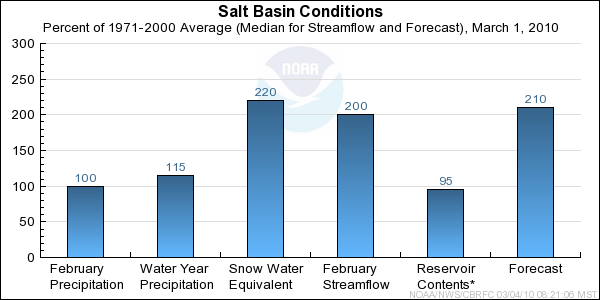
* Percent usable capacity, not percent average contents.
Click for multi-month Graph.
Gila Basin Conditions
The following conditions influenced this month's forecasts:
Precipitation:
Seasonal October-February
precipitation is near 110 percent of
average in upper Gila River Basin.
February
precipitation ranged from 100 to 115 percent of average in the upper Gila River Basin.
Streamflow:
February streamflow volumes were 160 to 200 percent of median in the San Francisco and upper Gila River Basin.
Snow:
Upper Gila Basin snowpack conditions ranged between 170 to 250 percent of average on March 1st. Record to near
record snow pack exists in high elevations of the San Francisco drainage. March 1st snowpack in the San Francisco drainage ranged from 170 to 400
percent of average.
Upper Gila Basin
Snow Plot.
San Francisco Basin
Snow Plot
Soil Moisture:
Modeled soil moisture conditions in the upper Gila and and San Francisco drainage are wetter than this time
ast year due to rainfall in January and February. The exception are higher elevations where snowpack has persisted
through the winter. In these areas modeled soil states are drier and they have changed little since the
beginning of the season.
Climate Forecasts:
El Nino climate conditions suggest increased chances for precipitation in this area.
The El Nino influence was accounted for in generation of these forecasts.
Forecast Summary:
Above average snowpack exists in the upper Gila Basin with near record snopwack for this time of
year in the San Francisco drainage. Above average rainfall is anticipated this spring due to the El Nino climate condition.
Additional rainfall and runoff from snow melt are expected to yield
March through May
streamflow volumes between 150 and 250 percent of median. Significant rainfall combined with snow melt would result in
larger volumes.
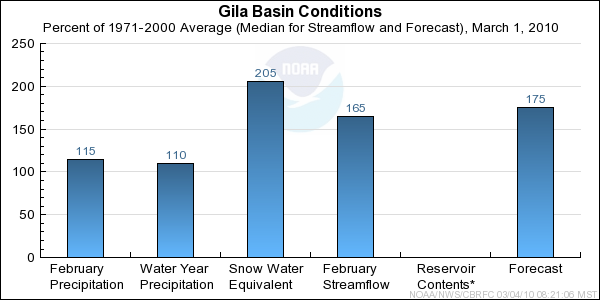
* Percent usable capacity, not percent average contents.
Click for multi-month Graph.
Little Colorado Basin Conditions
The following conditions influenced this month's forecasts:
Precipitation:
Seasonal October-February
precipitation is near
average throughout the Little Colorado Basin.
February
precipitation ranged from 60 to 110 percent of average. Headwater locations were near
90 percent of average. This followed a very wet January that observed monthly totals ranging from 240 to 380 percent
of average.
Streamflow:
February streamflow volumes in the Little Colorado were below median in the higher elevations. This
was due to below average precipitation and below average temperatures for the month that retained
the snowpack preventing much snow melt.
Snow:
Basin snowpack conditions ranged frome 160 to 370 percent of average on March 1st
in the Southern Headwaters of the Little Colorado Basin.
Little Colorado Southern Headwaters
Snow Plot
Central Mogollon Rim
Snow Plot
Soil Moisture:
Modeled soil moisture remains slightly drier than this time last year under areas of
continous snowpack. At lower elevations below the snow line soil moisture states have
become much wetter since early in the season.
Climate Forecasts:
El Nino climate conditions suggest increased chances for precipitation in this area.
The El Nino influence was accounted for in generation of these forecasts.
Forecast Summary:
A significant snowpack exists in higher elevations of the Little Colorado drainage.
Although dry soils under the snowpack could act to reduce snow melt runoff, snow melt is still
expected to provide a significant contribution to
March through May streamflow volumes this year. This is most likely in smaller high
elevation tributaries in close proximity to the snowpack. Above average precpitation is
anticipated this spring due to El Nino climate conditions.
March through May
streamflow volumes from near 150 to 560 percent of median are expected. Significant rainfall combined with
snow melt would result in larger volumes.
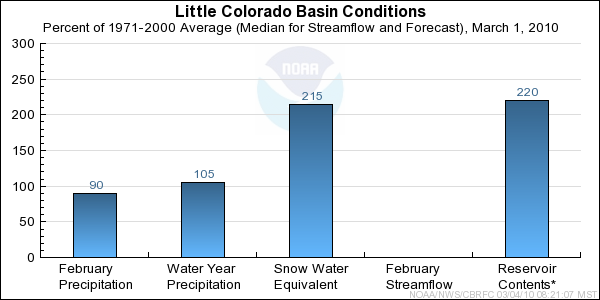
* Percent usable capacity, not percent average contents.
Click for multi-month Graph.
Differences between the full period forecasts and the residual forecasts may not exactly equal the actual observed volumes due to rounding conventions (see Definitions section).
Monthly Streamflows
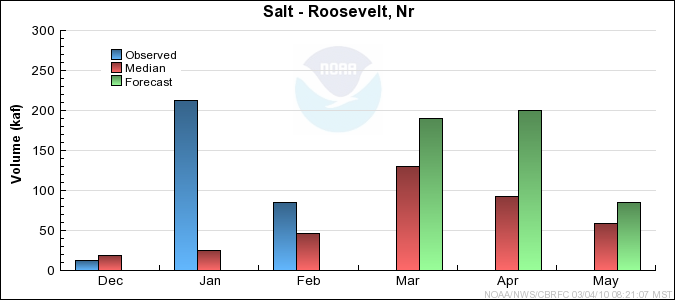
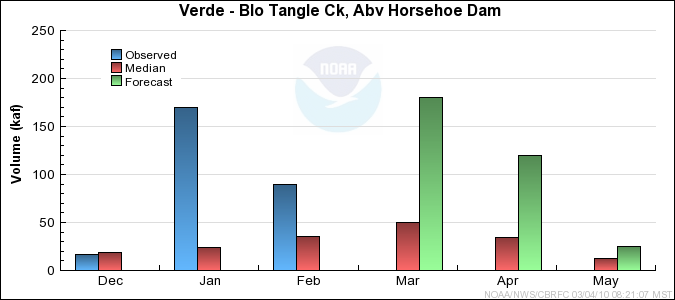
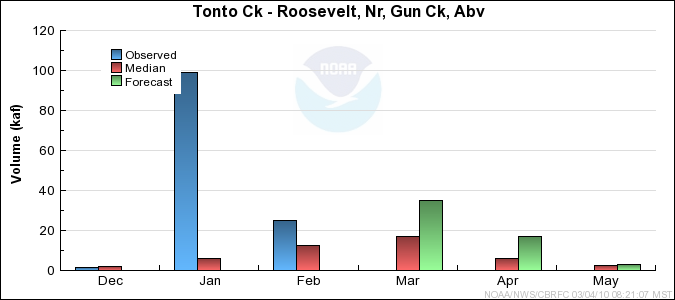
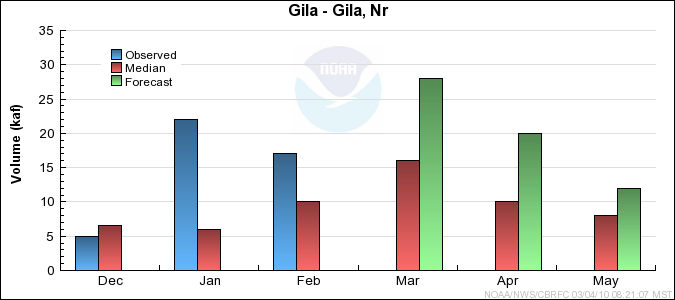
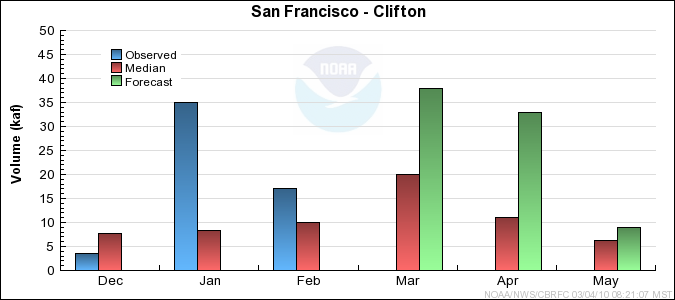
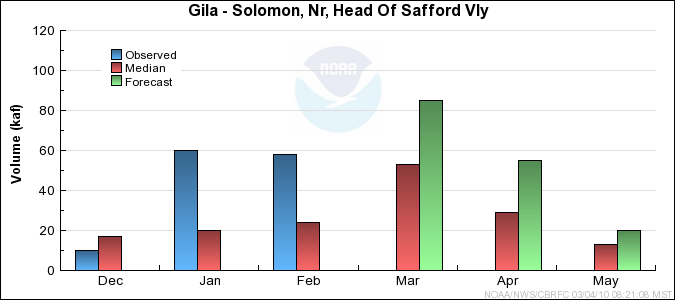
Precipitation Maps
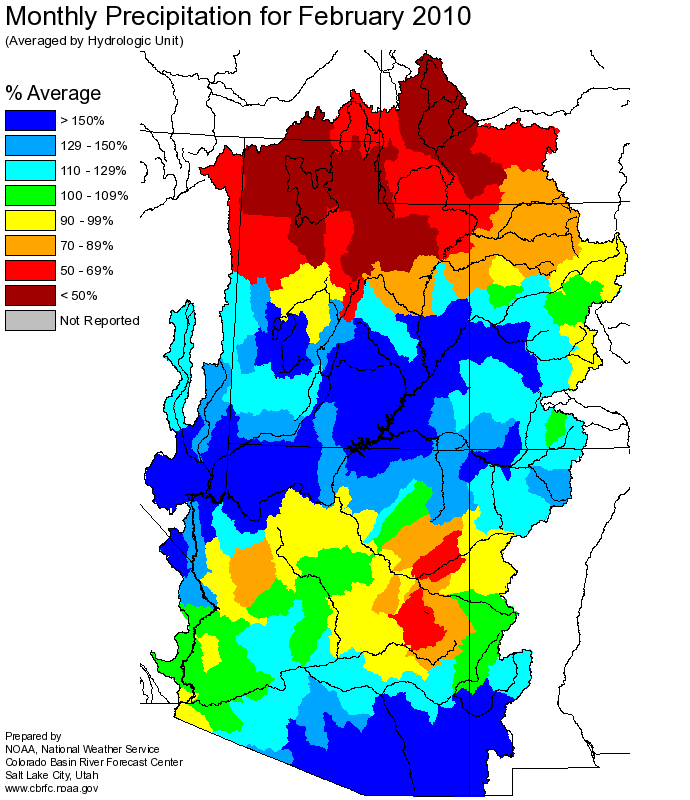
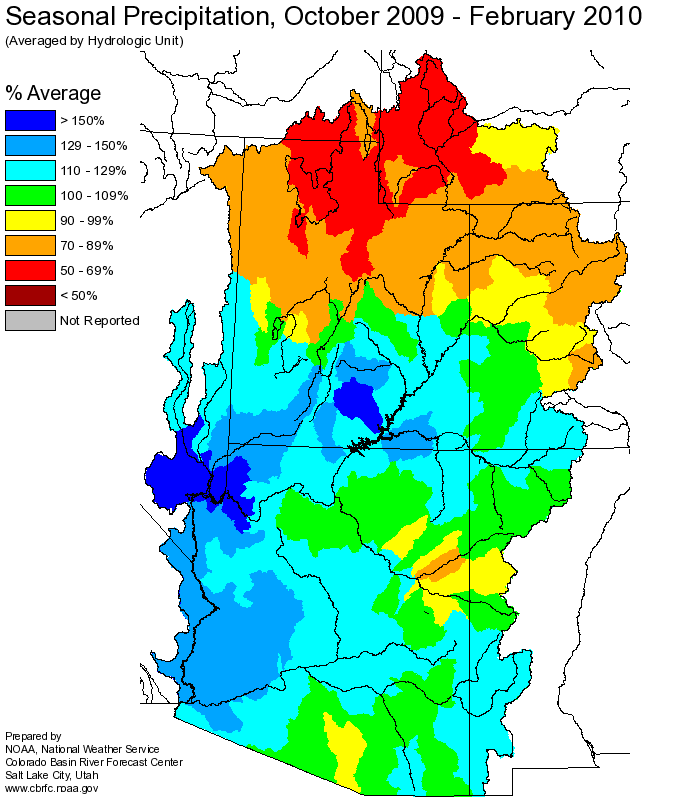
Hydrologist: G. Smith













